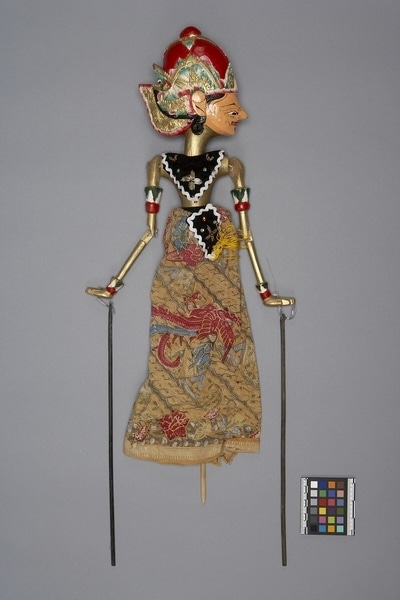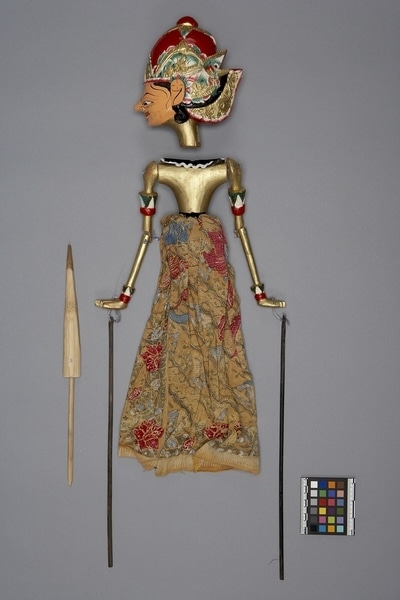Rod Puppet Item Number: Ib398 a-c from the MOA: University of British Columbia


Description
Three-dimensional male humanoid puppet: large head (part b) fits into body with skirt (part a), and a control rod (part c) with a long shaft that passes through the body and fits into the neck of the figure's head. The body has jointed arms, each with a long controlling rod attached. Pale orange face, positioned downwards; small pointed, curved nose, small white eyes with black pupils, red lips. Moustache, beard, hair, facial detail in black. Large red crown (mahkota) headdress with simple forward diadem (jamang), more elaborate karawista and badong in gold, red, and green. Green Garuda Mungkur with black tail. Single black curl of hair. Gold neck and upper torso; arms with green, white, red ornaments at wrist and bicep. Hands held flat and bent back at wrist. Black chest covering and apron with white trim, sequins and wrapped wire. Apron has black waistband and yellow fringe at bottom. Long batik skirt beige, red and blue.
History Of Use
Javanese puppetry as an art form probably developed by the 11th century. Wayang golek puppets of western Java appeared during the 16th century. Originally the plays depicted Javanese mythology, but after the Indian conquest of Java the Hindu epics, Ramayana and Mahabharata, were incorporated into the cycles, which comprise about 200 plays. A dalang (puppet master) performs the plays to celebrate important occasions, usually in three acts, with vocal and instrumental accompaniment. Typically they serve a moral and religious purpose, and more recently, one of political commentary. Several characters have different representations to portray differences in mood, state, or role. This puppet seems to be an aspect of Shiva, who is an incarnation of the god Vishnu in the Mahabharata. Shiva is the king (prabu) of the Hindu pantheon. His sons are among the principle gods. He appears in all cycles.
Cultural Context
Theatrical performance.
Iconographic Meaning
Each puppet is characterized by its wanda, a Javanese word which describes the specific mixture of elements of size, form, colour, ornamentation and carving. Pale orange (cream?) face slightly less refined than white. Position of head and eyes, skin colour, batik, indicate nobility. Crown identifies character as either a king (prabu) or a god (betara). Large size of puppet suggests the latter. Crown, face identifies character as a manifestation of Shiva. Note differences: simple diadem, moustache.
Item History
- Made in Java, Indonesia
- Owned by Donald Bone before January 4, 1980
- Received from Donald Bone (Seller) and Museum of Anthropology Donations Fund (Funding source) on January 4, 1980
What
- Name
- Rod Puppet
- Identification Number
- Ib398 a-c
- Type of Item
- puppet
- Material
- fibre, paint, cotton fibre and wood
- Manufacturing Technique
- carved, tied, woven, sewn and painted
- Part A
- height 64.0 cm, width 19.0 cm, depth 6.5 cm
- Part B
- height 19.0 cm, width 8.5 cm, depth 16.5 cm
- Part C
- height 35.5 cm, width 2.7 cm, depth 1.7 cm
Who
- Culture
- Sundanese
- Previous Owner
- Donald Bone
- Received from
- Donald Bone (Seller) and Museum of Anthropology Donations Fund (Funding source)
Where
- Holding Institution
- MOA: University of British Columbia
- Made in
- Java, Indonesia
When
- Ownership Date
- before January 4, 1980
- Acquisition Date
- on January 4, 1980
Other
- Condition
- fair
- Accession Number
- 0586/0017 a-c